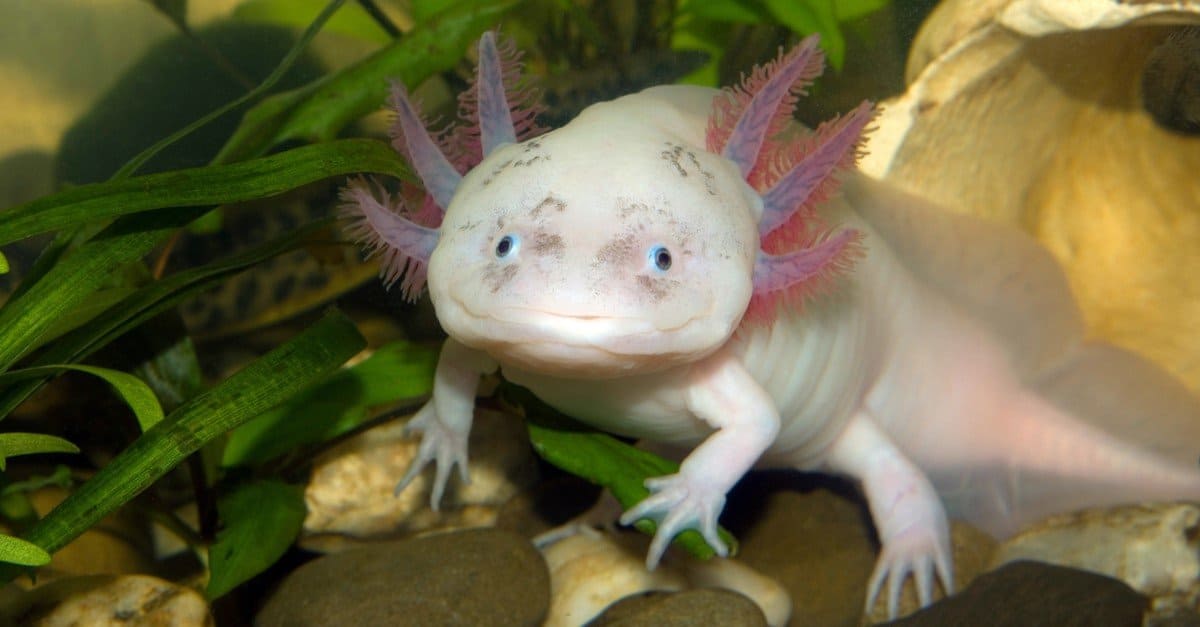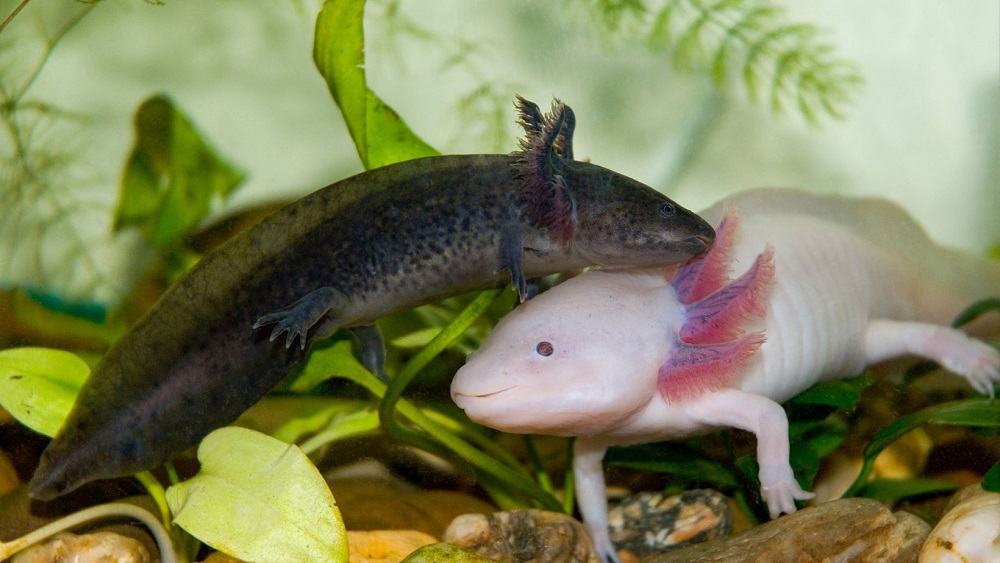Although axolotls are a member of the amphibian family, they are genetically related to salamanders, and many axolotls have been interbred with them. Since they are so closely related, viable offspring can be produced. However, unlike other amphibian family members, such as frogs, newts, and salamanders, axolotl does not undergo a metamorphosis to develop lungs and live on land.

Axolotls are paedomorphic, unlike their close relative’s salamanders, meaning that they retain some of their juvenile features in adulthood. This happens because their bodies don’t produce the hormones necessary to tell their bodies to age. By hybridizing the two relatives, axolotls are provided with various options in their later life. Some will remain aquatic axolotls, whereas others will become rare axolotl morphs.
Witnessing this process can be shocking to unaware pet parents, so here is everything you need to know about axolotl morphing, how to care for them, the causes, what to do, and more – read on to learn more.
How Do You Know If Your Axolotl is Morphing?
The first step is learning how to identify whether your axolotl is morphing or not and what signs you should be looking out for. Fortunately, the symptoms are usually relatively easy to identify, and once you start to look for and place them, you will be able to start preparing for the transformation.
Some of the most common signs that your axolotl is morphing are as follows:
- Eyelids will start to form.
- The eyes will begin to bulge.
- Its tail and dorsal fin will start receding.
- The gills will become extinct, or they might be removed altogether.
- Behavioral changes within the animal.
- Physical changes within the animal, mainly color differences.
- The limbs will become thicker as they’ll be needed for walking.
- The axolotl will find it challenging to swim and re-surface for oxygen more often.
As listed above, those are the signs you should look for if you suspect that your axolotl is morphing into a salamander. Since it is an entirely different animal, you should find that the changes are easy to spot and that you should act fast once you realize they’re appearing.
If you’d like to discover more about axolotl morphing, use helpful internet resources and guides like ‘What Causes An Axolotl To Morph?’ by Pawfect Paw Print, whose website is full of guides, articles, and posts designed to help pet owners care for their animals in the best way possible.
As well as producing resources for axolotl owners, they also make content about cats, dogs, birds, and other animals – meaning that most pet owners can utilize their resources. For more insight, consider heading to their website and using their media to develop your knowledge about axolotl morphing.

What Causes An Axolotl To Morph?
Although several reasons have been speculated, little is known about what causes an axolotl to morph. At times this process occurs naturally due to the axolotl’s genetic make-up, which is something that cannot be stopped. On the other hand, an axolotl may morph due to environmental factors.
Your axolotl may morph due to poor water conditions. Failure to routinely check the parameters can cause hygiene levels in your axolotl tank to drop, meaning that your pet could be at risk of contracting secondary infections from the build-up of bacteria and parasites that could trigger the transformation.
Another reason that your axolotl may morph is due to overcrowding. It is recommended that you keep your axolotl in a tank that is ten gallons, although you may find that caring for your pet is more manageable in a twenty-gallon tank. If you are planning to keep multiple axolotls together, it is suggested that you increase the size of the tank by ten gallons per animal.
Overcrowding can encourage the growth of disease, injury, and morphing as there is insufficient space for the axolotls to co-exist since they cannot get away from each other. Due to this, you may find that the stress levels of your axolotls will increase, which is one of the speculated causes of axolotl morphing.
An overpopulated tank can also cause a high ammonia output, which will not be able to keep up with no matter how often you maintain your tank’s filter and water. Although overcrowding is a common cause of morphing, many pet owners rarely keep multiple axolotls in the same tank.
Can You Force An Axolotl To Morph?
It is possible to force an axolotl to undergo the morphing transformation by injecting the animal with iodine. However, this can only be done by scientists and experts in the field since it puts the animal under much stress and can cause it to die in the worst-case scenario. Since axolotls are paedomorphic, metamorphosis is not a part of their evolutionary build-up; it does not need to be forced upon them as it puts them through pain and could kill them.
What Is A Morphed Axolotls Lifespan?
Providing that the animal survives the entire transformation, the lifespan of a morphed axolotl can vary significantly. The average lifespan of a morphed axolotl can vary cause of various factors such as the age of the axolotl when it transformed and the conditions which caused the animal to morph.
The younger the axolotl is when it undergoes the transformation process, the higher its lifespan will be. Providing that it is cared for properly post-transformation, there is no reason why a morphed axolotl will not live for the average lifespan of a non-morphed axolotl which is around ten to fifteen years.
On the other hand, if the axolotl is old when it transforms, the higher the likelihood of it not surviving the transformation, or if it does, the lower its survival rate will be. It could live for a year, or even less in some cases.
It is hard to estimate a morphed axolotl lifespan as the reports from various pet owners that have witnessed the change vary from person to person. Some pet owners have succeeded with their morphed axolotls, whereas others have not.
